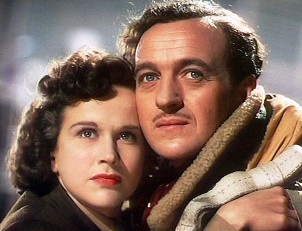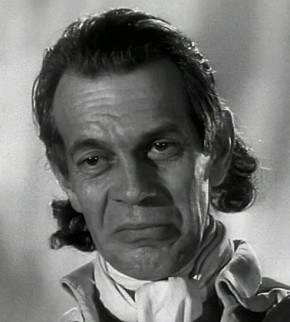

Produced, written and directed by Michael Powell and Emeric Pressburger and released in 1946, this was the first ever film to be granted a Royal Gala Performance. It is a masterpiece of visual flair and imaginative storytelling and remains one of my favourite films. Like many great films it defies easy categorisation.
It tells the story of Peter Carter, a young World War 2 Royal Air Force pilot (played by David Niven) who is trying to return his badly damaged Lancaster bomber to base. His crew have already bailed out, but his parachute has been shot to pieces. Before he is forced to jump out, he manages to get in touch with an American radio operator called June (played by Kim Hunter). Carter miraculously survives, waking up early the next day on a beach near the American base. He meets June on the way back from her night shift and they fall in love.
Peter Carter should have died that night but because of a mistake by a mysterious guide from another world, called “Conductor 71”, who missed Peter falling in the thick fog over the Channel, his life was saved. Conductor 71 is a French aristocrat executed during the French Revolution, and is theatrically played by Marius Goring. Conductor 71 appears to Peter and stops time to tell him that he should accept his “fate” that he should die. Peter refuses and demands an appeal, continuing to live his life. Peter’s visions of the conductor are evidence of a rapidly progressing brain injury diagnosed by his friend Dr.Reeves (Roger Livesey – an actor famous from another Powell and Pressburger film – the Life and Death of Colonel Blimp). Before Dr. Reeves can operate, he is killed in a motorcycle accident, but then becomes an advocate for Peter in this other celestial world. He argues that because Peter has fallen in love, he now has obligations on earth which must be fulfilled. He has to make his case against a celestial prosecutor killed by the British during the American Civil War – played by Raymond Massey.
The directors use colour for the “real-life” scenes and black and white for the celestial world, which is reached by an enormous moving stairway ascending from earth. The celestial court scenes convey an other-worldly quality, and there is one remarkable shot where the camera pulls back to show that the court includes an afterlife as large as a spiral galaxy. The case for Peter Carter defying his fate rests with him being able to prove that he really has fallen in love since his survival from the crash.
The film displays an absolute technical mastery, especially where ordinary time is “frozen” to enable the celestial characters to descend to earth to determine what is going on. There are other shots which surprise the viewer, such as the shot taken through Peter Carter’s eyes as they close in the operating theatre for his life saving operation. But the real master here is the story – which interweaves ideas of man’s fate, love, sacrifice, the relativity of time (the celestial world operates at a far greater speed than our ordinary world) and eternity into an everyday tale of boy meets girl.
